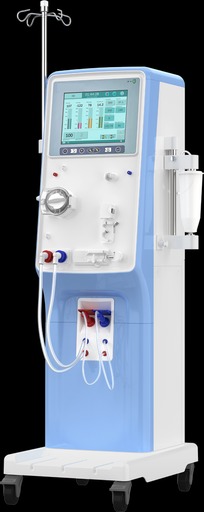Living with kidney failure can be daunting, but advances in medical technology, particularly dialysis machines, have made it possible for many to lead healthier, longer lives. In this article, we’ll delve deep into the workings of dialysis machines, their types, and the role they play in treatment, while addressing common questions and concerns from patients and caregivers.
1. Introduction to Dialysis Machines
When the kidneys fail to perform their essential function of filtering toxins and waste products from the blood, dialysis steps in as a life-saving procedure. Dialysis machines mimic kidney functions, helping individuals with chronic kidney disease (CKD) maintain their quality of life.
💡 Did You Know? As of 2023, approximately 2 million people worldwide rely on dialysis to survive, according to the International Society of Nephrology.
2. How Does a Dialysis Machine Work?
A dialysis machine removes toxins, waste, and excess fluid from the blood. Here's how it works:
- Blood Flow: Blood is drawn from the body via a tube connected to a vein.
- Filtration: The machine pumps the blood through a filter, called a dialyzer, which acts as an artificial kidney.
- Return: Clean blood is returned to the body.
Key Components:
- Dialyzer (Artificial Kidney): Separates toxins and waste from the blood.
- Dialysate Solution: A specially formulated fluid that absorbs unwanted substances.
- Pump System: Controls blood flow and pressure.
📈 Quick Fact: Hemodialysis typically removes 1–3 liters of fluid per session, depending on the patient’s condition.
3. Types of Dialysis Machines: Hemodialysis vs. Peritoneal Dialysis
Hemodialysis Machines
Used in clinics or at home, these machines circulate blood through an external filter.
- Pros: Highly effective at toxin removal.
- Cons: Requires vascular access and frequent visits to a clinic.
Peritoneal Dialysis Machines
These use the lining of your abdomen (peritoneum) as a filter, allowing dialysis at home without needles.
- Pros: Greater flexibility and fewer dietary restrictions.
- Cons: Requires meticulous hygiene to prevent infections.
4. Who Needs Dialysis and When Is It Necessary?
Dialysis becomes necessary when kidney function drops below 15% of normal levels, as indicated by a low Glomerular Filtration Rate (GFR).
👩⚕️ Patients Most Likely to Need Dialysis:
- Those with End-Stage Renal Disease (ESRD).
- Individuals with severe electrolyte imbalances or fluid overload.
🌟 Fact: In the U.S., Medicare covers dialysis for 80% of patients, making it accessible for most in need.
5. What to Expect During a Dialysis Session
Understanding what happens during dialysis can ease anxiety for new patients.
A Typical Hemodialysis Session:
- Step 1: Preparation and vascular access setup.
- Step 2: Blood is drawn, filtered, and returned.
- Step 3: Post-treatment rest.
⏱️ Time Commitment: Each session lasts 3–5 hours, usually three times a week.
6. Potential Side Effects and How to Manage Them
While dialysis is essential, it’s not without challenges.
Common Side Effects:
- Fatigue
- Muscle cramps
- Low blood pressure
Management Tips:
- Stay Hydrated: Manage fluid intake as directed by your doctor.
- Nutrition: Focus on a kidney-friendly diet rich in low-potassium and low-phosphorus foods.
- Exercise: Regular light activities can reduce fatigue.
7. Home Dialysis Machines: Pros and Cons
As technology evolves, more patients are opting for home dialysis.
| Pros | Cons |
|---|---|
| Flexible scheduling | Higher upfront costs |
| No travel required | Requires training |
| Greater independence | Risk of infection |
8. Advancements in Dialysis Machine Technology
The future of dialysis looks promising with innovations focused on portability and efficiency.
Recent Developments:
- Wearable Dialysis Devices: Compact, wearable devices are being developed for continuous blood filtering.
- AI Integration: Advanced algorithms predict patient needs, optimizing treatment.
9. Cost and Insurance Coverage for Dialysis Treatments
The financial burden of dialysis can be significant, but assistance is available.
Insurance Coverage: Most health insurance plans, including Medicare, cover the majority of costs.
10. Frequently Asked Questions About Dialysis Machines
- Q: Can dialysis completely replace kidney functions?
- A: No, dialysis supplements kidney functions but cannot replace them entirely.
- Q: Is dialysis painful?
- A: The process is usually painless, though needle insertion can be uncomfortable.
- Q: Can I travel if I’m on dialysis?
- A: Yes, with planning. Many centers offer transient dialysis for travelers.
Have questions? We offer free consultation.
Conclusion: A Lifeline for Kidney Patients
Dialysis machines are more than just medical devices—they’re lifelines for millions worldwide. By understanding how these machines work, their types, and their impact, patients and caregivers can make informed decisions about treatment.
💡 Final Tip: Always consult with a nephrologist to determine the best dialysis option for your unique needs.
→Click here to learn more about our dialysis machine
or
